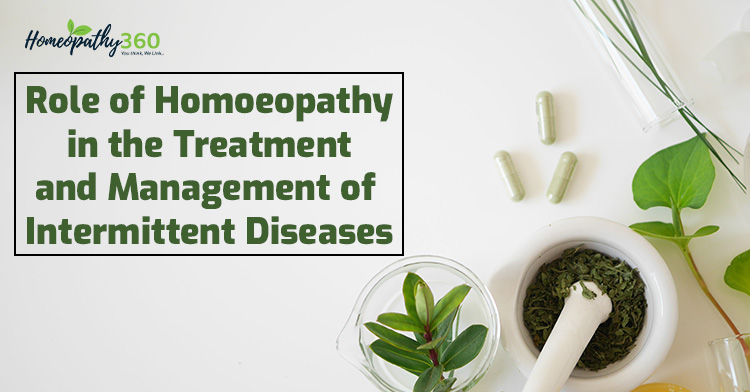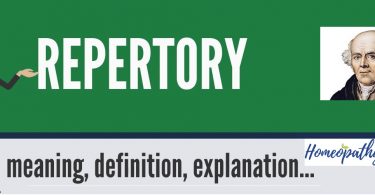
Role of Homoeopathy in the Treatment and Management of Intermittent Diseases
[Abstract: In this article we would like to understand the Intermittent Diseases, on the light of the teaching of Organon of Medicine & Homoeopathic Philosophy, and how they were treated and managed also expressed in this article.]Keywords: Intermittent diseases-definition-types-significance in medicine-treatment-management.
Definition: Intermittent diseases are such symptoms-syndromes, chronic in type, psoric in nature, sometimes may mixed with syphilis also; and those are recur at certain periods, in an interval between the two paroxysms of attacks; during which patient remains apparently free of symptoms.
Types: They are two types.
- Typical Intermittent Diseases. (§ 233 – 244) [1]
- Alternating Diseases. (§ 231 – 232) [2]
Non-febrile/Afebrile, Typical Intermittent Diseases (§ 234): [3]
These are typical intermittent disease, where a morbid state of un-varying character returns at a tolerably fixed periods, whereas the patient is apparently in good health, and takes its departure at an equally fixed periods, without any fever.
- These are not usually appearing Sporadically or Epidemically.
- They are always belong to the Chronic in type, mostly and purely in Psoric origin, but seldom complicated with Syphilis also.
Treatment:
- When it’s purely Psoric in origin, may be successfully treated by anti-psoric medicines.
- When complicated with Syphilis, may cure by alternating anti-psoric with anti-syphilitic medicines. (§ 232 – 234) [4]
- Sometime, it is necessary to employ asmall dose of potentised solution of Cinchona Bark as an intermediate remedy to extinguish completely the intermittent character of the disease. (§ 234) [5]
Alternating Diseases (§ 231, 232) [6]
Definition: Alternating Diseases are such symptom-syndromes where certain morbid state alternates at uncertain intervals with morbid states of different kind.
- They are belonging to the class of Chronic disease, generally of developed Psora, but seldom complicated with Syphilis.
For examples:
- Certain leg pains may occur immediately on the disappearance of a kind of Ophthalmia.
- Convulsions and spasms may alternate with any other affection of the body immediately.
- Happy to Melancholy etc.
Treatment:
- When it’s purely Psoric in origin, may be successfully treated by anti-psoric medicines.
- When complicated with Syphilis, may cure by alternating anti-psoric with anti-syphilitic medicines, respectively.
INTERMITTENT FEVER
Definition: Intermittent Fever is a typical type of intermittent disease, febrile in type, where the morbid state recurs at almost a fixed period of interval, but the patient enjoys apparently good health during the interval between the two paroxysms of the morbid state. (§ 231 – 244) [7]
Types: Dr. Hahnemann clinically classified it into four types.
- Intermittent Fever of Sporadic or Epidemic, not Endemically located in marshy districts. (§ 235 – 240) [8]
- Intermittent Fever of Epidemic, not Endemically located in marshy districts. (§ 241, 242) [9]
- Pernicious Intermittent Fever, attacking individual, not in marshy districts. (§ 243) [10]
- Intermittent Fever, Endemic in marshy districts. (§ 244) [11]
Description of Different Types:
Intermittent Fever of Sporadic or Epidemic, not Endemically located in marshy districts. (§ 235 – 240): [12]
These are those type of intermittent fever, prevail sporadically or epidemically and not endemically located in marshy districts.
Features are:
Here, every paroxysm recurs likewise composed of either:
- Two opposite alternating states, as chill, heat – to – heat, chill.
- Three alternating states, as chill, heat, sweat.
Treatment:
- Firstly, an acute superficial, non-anti-psoric remedy should be selected.
- This remedy must have either two or all three similar alternating states or any one of them as a most peculiar similarity with the patient.
- If the specific homoeopathic remedy fail, then the anti-psoric must be given until the complete relief is obtained.
- During the intervals, when the patient is free from fever must be the chief guide to the most appropriate homoeopathic remedy.
- Proper time for administration and repetition of remedy must be selected correctly, as per the rules of Second Prescription.
Intermittent Fever of Epidemic, not Endemically located in marshy districts. (§ 241, 242): [13]
These are that type of intermittent disease chronic in nature, prevailing epidemically, but not endemically located in marshy districts.
Features are:
Here, single acute paroxysm, a peculiar, uniform character, common to all the individuals attacked.
Treatment:
- Based on the totality of symptoms, common to all patients (group totality or collective disease), suitable specific remedy for all cases can be selected.
- Such Genus Epidemicus is serviceable universally to all patients, who enjoyed perfect health before the occurrence of such epidemic (means who were not the chronic sufferer of Psora § 241). [14]
- But, instead of treating with ‘Genus Epidemicus’ or left un-cured or treated with the improper allopathic treatment, the inherent, latent psora becomes developed.
- It takes the form of ‘psoric intermittent fevers’.
- In this stage regular medicines are of no use, but anti-psoric medicines have to be given.
- This type of case will be subdued by minute and rarely repeated doses of Sulphur or Heper sulphur in a high potency (§ 242). [15]
- Proper time for administration and repetition of remedy must be selected correctly, as per the rules of Second Prescription.
Pernicious Intermittent Fever attacking individual, not in marshy districts. (§ 243): [16]
These are the type of intermittent disease generally acute in nature, attacking individual in non marshy districts and not endemically located.
Treatment:
1) Firstly, an acute non-anti-psoric remedy should be selected.
2) If the well selected remedy fails within few days than anti-psoric remedies are needed, which alone can affect a radical cure.
3) During the intervals, when the patient is free from fever must be the chief guide to the most appropriate homoeopathic remedy.
4) Proper time for administration and repetition of remedy must be selected correctly, as per the rules of Second Prescription.
Intermittent Fever, Endemic in marshy districts. (§ 244): [17]
These are endemically prevalent in marshy districts, where a healthy man may remain un-affected, if diet and regimen is properly regulated, but may suffer from its first arrival on that place.
Treatment:
Attacks of healthy man, on its first arrival should be treated with one or two very small doses of highly potentised Cinchona, with well mode of living.
In weak or in case of all types of working peoples, following masers are to be taken:
1) Good diet and regimen are to be supplied for the patient.
2) Adopted well regulated mode of living.
3) Change from marshy districts to a dry, mountainous place which can ensure recovery, due to removal of the causative factors.
4) Here, Cinchona cannot cure the case.
5) In-spite of all the management, anti-psoric treatment (Sulphate of quinine) must be needed to regain perfect health of the patient.
6) During the intervals, when the patient is free from fever must be the chief guide to the most appropriate homoeopathic remedy.
7) Proper time for administration and repetition of remedy must be selected correctly, as per the rules of Second Prescription.
Proper Times for Administration of Remedies in all Intermittent Fever (§ 236, 237): [18]
1) The remedy should be given, immediately or very soon after the end of the paroxysm.
2) In case of very short interval, selected medicine should be administered when the perspiration begin or during the decline of the paroxysm.
Repetition of Medicinal Doses in all Intermittent Fever (§ 239, 240): [19]
1) A single dose may destroyed several attacks but, majority of cases needs another dose, after each attack, provided the totality of the symptoms remain the same.
2) In LM Potency of the specific medicine, successively with 10/12 succession may repeat for several days, till cure.
Conclusion:
We the homoeopaths having enough intelligence … primarily identifies and classifies our cases of Intermittent Diseases and treat according to our teaching of our Organon of Medicine and Homoeopathic Philosophy and we will also see the Hering’s Law of the Directions of Cure, and finally we can successfully manage the Intermittent Diseases. Here, ‘We must know the symptoms of the disease and then the symptoms of the patient for our best cure and where the symptoms of the patient are more clearly available hope of cure also more, and where fade make it difficult to cure’. [20]
Bibliography:
1) Boericke W, Organon of Medicine; S. Hahnemann, translated by R. E. Dudgeon; Indian edition, Calcutta, Roy Publishing House, 1961, [1, 2, 3, 4, 5, 6, 7, 8, 9, 10, 11, 12, 13, 14, 15, 16, 17, 18, 19]
2) Schmidt Dr. Pierre, Classic Touch of Case Taking; Rup Publication, 10, S.C. Dey Street, Kolkata -700073 [20].
About Author:
Prof. (Dr.) Goutam Das M.D. (Homoeopathy)
Dept. of Organon of Medicine, AJSHMC&RI, UG, PG, Mehsana, (Gujarat)
Assist By:
Dr. Bhavana Chaudhary B.H.M.S.., M.D. (Homoeopathy) Scholar
Part – 1, Batch: 2022 – 2025, Dept. of Organon of Medicine and Homoeopathic Philosophy, AJSHMC&RI, Mehsana, (Gujarat)





